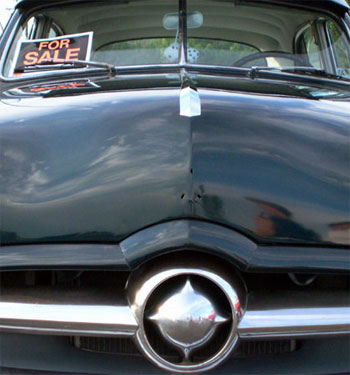Media | Articles
Spotting Bad Bodywork
Most vehicles offered for sale in car corrals and auctions look pretty good on the surface, because they’re being sold by knowledgeable private collectors or collector-car dealers. These are people who know how to make cars and trucks look their best, which is their “job” as the seller. They’re trying to highlight their vehicle’s strong points by detailing it.
As the buyer, you have to learn to look past super wax jobs, chrome polish and Armor-All-coated interiors to get a true idea of condition. Cars and trucks with a few flaws may be worth fixing, if you can buy them “right.” On the other hand, you don’t want to pay a No. 1 price for a well-detailed No. 3 car.
Get to the car corral or auction as early as possible and carefully look over the cars you’re interested in. Check for signs of bodywork problems such as bulging panels, close but different colors of paint and missing seams covered up by filler. The worst flaws may show up behind wheel lips, on the underside of rocker panels and around the filler panels between the bumpers and body.
Some large auctions offer professional detailing services. If you spot a car you’re considering buying and it’s being detailed, watch it being cleaned. Strike up a conversation with the detailer and ask if he or she saw anything out of order.
A number of magnetic tools are available to check for vehicles that have been repaired with plastic and fiberglass body filler. Some are flat and others resemble a syringe with gradations marked on them. The idea here is that the magnet will pull out different lengths depending upon the amount of filler used, and the scale on the tool will indicate how thick the filler is.
Marketplace
Buy and sell classics with confidence
When you see a car with panels that fit badly, bulge, pinch or “wave,” something isn’t right. Some such problems are caused by the use of aftermarket body repair panels, which can’t be formed as perfectly as original panels made on an expensive body die. If you find panels like this, you’ll have to make a judgment call. Some are perfectly functional, though they just don’t have a “factory correct” look. Others are cheap, sloppily made and too thin to last very long. If you have questions, talk to the car owner. The best way to go into it is to accept nothing less than “factory spec,” but that’s not always possible with older cars.
You could take your panel inspection one step further by bringing a body professional to the auction with you or looking for one to hire while you’re there. This pro should be able to make a good assessment of whether the repair is done as good as it can be. Whether this kind of help is worth the expense involved depends on how much the car is worth. If you’re spending tens of thousands of dollars, a professional’s opinion should be worth having.
John “Gunner” Gunnell is the automotive books editor at Krause Publications in Iola, Wis., and former editor of Old Cars Weekly and Old Cars Price Guide.










